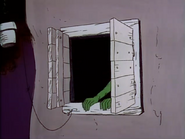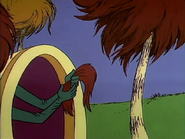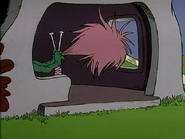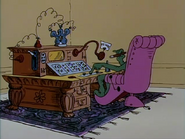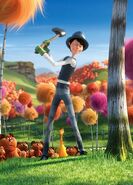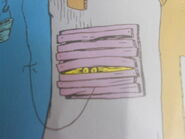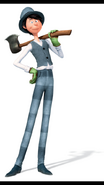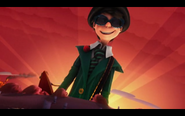| “ | UNLESS someone like you cares a whole awful lot, nothing is going to get better. It's not. The Once-ler's infamous quote. (Book, TV Special, Movie.) |
” |
The Once-ler is the narrator of The Lorax and one of the main characters of the 2012 film adaptation of the same name. He was a greedy industrialist who cut down all of the multicolored Truffula Trees to make a multipurpose garment known as a Thneed, a "Fine-Something-That-All-People-Need." He is currently a recluse who lives in his Lerkim, plagued by the guilt of what he had done to the forest. He is voiced by Bob Holt in the 1972 television special and Ed Helms[2] in the 2012 movie adaptation.
Biography
The Lorax (1972 TV special)
One day, the Once-ler discovers a valley full of Truffula Trees in which the Bar-ba-loots, Swomee-Swans, and Humming-fish inhabit. He decides to cut down one of the trees for his invention, the Thneed. When he chops down a Truffula Tree, he finds the Lorax in the tree trunk. He receives a warning about destroying the forest for his greedy plans. The Once-ler does not listen and continues to cut down trees to create Thneeds to sell.
As the Once-ler's small shop grows into a factory and new equipment is being made to keep up with the demand for more Thneeds, signs of damage to the Truffula Forest become evident to the Lorax. The Lorax first complains to the Once-ler that the Truffula trees, being chopped down, were also the food source of the Bar-ba-Loots, who are now facing a terrible food shortage and implied illness (stated illness in the book called the Crummies, caused by gas instead of food being in the stomach). To save them, the Lorax sends them off to find another food source. At first, the Once-ler only shows a little remorse but still focuses on expanding his business.
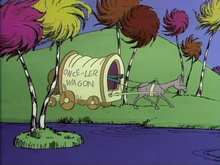
Soon, the Once-ler's Thneed-making business expanded tenfold and now uses delivery trucks to take out the shipments. The Lorax eventually comes back complaining to the Once-ler that the factories are belching out so much smogulous smoke that it is giving the Swomee-Swans sore throats, leaving them unable to sing, so the Lorax sends them off. The Once-ler then says that shutting down his factory would put 100,000 workers out of a job, which would not be economically sound for the country. The Lorax contemplates his point but says he wouldn’t know the answer to the problem. The Once-ler says he’ll think about it, but the Lorax refuses to believe him this time. He then complains to him about his machinery making a goo by-product called Gluppity-Glupp and Schloppity-Schlopp and how it is being dumped into the ponds where the Humming-fish live, leaving them unable to hum and forcing the Lorax to send them away too.
The Once-ler begins to see the light, but Miss Funce-ler calls him via a phone and informs him that Thneeds Inc.'s stock has risen 27 5/8 points. He then dismisses the Lorax's pleadings, berating the Lorax for chastising his business practices, and tells the Lorax he is figgering on biggering and turning more Truffula Trees into Thneeds, “which everyone needs.” The Lorax's complaints, however, unhappily prove to be true just as the last Truffula Tree gets chopped down. With all the trees gone, no more Thneeds can be made, so the Thneed factories close down. The Once-ler's family departs, leaving the Once-ler alone with the Lorax, who, looking back at the Once-ler sadly, picks himself up by the "seat of his pants" and floats away through a hole in the smog, leaving behind only a tiny pile of rocks with the word "UNLESS" inscribed into them.
The Once-ler alone remains, gazing upon the disintegrating ruins of his factories over the years and contemplating the meaning of this last message, perhaps with a sense of remorse. In the end, the Once-ler realizes what it means: unless someone who cares enough to make a difference comes along, things will either remain as they are or worsen until it's too late. And so, he gives the boy the very last Truffula seed for him to plant and take care of.
The Lorax (2012)
The Once-ler lived with his mother, brothers Brett and Chet, Uncle Ubb, and Aunt Grizelda. They all thought he would "amount to nothing," so when the Once-ler left to sell his invention, the Thneed, they were happy to laugh at his optimism. Even so, Once-ler continued to find the perfect material for his Thneed. After traveling in his fully loaded cart by his mule while playing songs on his guitar, he stumbles upon "the most beautiful place he had ever seen." The forest was filled with Truffula Trees, Bar-ba-loots, Swomee-Swans, and Humming-fish.
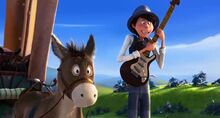
As he chops down his first Truffula tree, the Lorax is summoned from thunder in the sky and forms on the tree stump. The Lorax warns him, but the Once-ler ignores his threats.
On the night of his arrival, while he is peacefully sleeping, the Lorax, with the help of the Bar-ba-loots, the Swomee-Swans, and the Humming-fish, takes his bed and shoves him into the river. Unfortunately, their plan is ruined because one of the youngest Bar-ba-loots, Pipsqueak, also finds himself on the bed but cannot swim.
The Lorax saves Pipsqueak, as well as the Once-ler, and they make a deal. The Once-ler promises not to chop down any more Truffula trees, but the Lorax says he will keep an eye on him. As time passes, the Once-ler's Thneed gets discovered and is highly demanded. To fulfill that demand, the Once-ler calls his family to the valley to help him make the Thneeds by collecting the tuffs of the Truffula trees. However, his mother suggests he start cutting down the trees to make production faster, which he does.
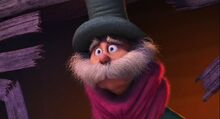
The Lorax calls the Once-ler out on his broken promise, but the Once-ler cannot see what he did wrong. After his family arrives in the valley, the once happy and kind Once-ler disappears and is replaced with a greedy, money-crazed salesman. He denies he has done anything wrong but feels incredibly guilty to see the last of the Truffula trees being chopped down. All the animals left, and the Lorax picked himself up and rose away, leaving a rock with the word "Unless" engraved. He stared at that word in his house for years, wondering what it meant. He told his story to a curious Ted Wiggins and gave him the last Truffula tree seed, righting his wrongs.
Design & Conception
The 1972 television special depicts the Once-ler much like he appears in the book, with an emphasis on his face not being shown.

This character trope,[3] typically associated with the narrative's main villain, is brought to life by employing various ways to hide a character's face in order to build a mystery around them. In the Once-ler's case, this is achieved by strategically framing him from camera angles that obscure his face, often positioning him behind something else such as a wall, an armchair, or a window. To avoid displaying his entire body, he was shown to move around half-lying in various wheelchairs with only his arms, legs and sometimes a cigar hanging from his mouth visible or other objects in his hands such as binoculars. Dr. Seuss's decision to leave the Once-ler faceless appears to be a deliberate narrative choice, supposed to illustrate the idea that "he can have anybody's face" and can represent anybody (or, alternatively, that "anybody can be the Once-ler").
His facelessness reinforces his representation as a broader critique of real-life issues like environmental issues and societal problems taken to the extreme such as money-driven industrialism and capitalism rather than a single identifiable individual.[4] The Once-ler symbolizes various individuals who share the common mindset of either exploiting nature for immediate gain without considering the long-term consequences, or those who are too careless or indifferent to the well-being of the environment. In agreement with one of the last sentences of the book, "Unless someone like you cares a whole awful lot, nothing is going to get better," his story could happen to anybody who isn't careful and doesn't care enough.
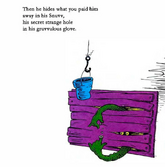
In the book, along with his workers/family, he seems to be wearing a pair of dark green shoulder-length gloves. He is mentioned to have a "Snuvv," a strange hole in his "gruvvulous glove." The TV special depicts him and his workers wearing plain, full green suits, visible when the Once-ler's arms and legs are shown, as well as during the scene where the workers are singing his hymn.
His name, "the Once-ler," seems to be taken from the stock phrase "Once upon a time" used to introduce a narrative of past events in tales. The Once-ler recounts the tale of the environment's extinction, essentially "Once"-ing the story to the young boy, making him a "Once"-ler.
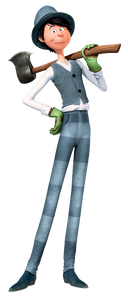
The 2012 film depicts him as a tall pale-skinned young man with short, fluffy black hair, freckles and light blue eyes, with his face revealed.


As he recounts the events leading up to his company's success, the Once-ler is seen dressed in a long-sleeved white shirt paired with a gray suit vest, blue-grayish striped pants in the pattern and colors of the Truffula Trees trunks, and wears a gray fedora and darker gray shoes. He puts on a long, loose blue pajamas with a yellow rabbit pattern when going to bed.
Additionally, when carrying his axe used to chop down the valley's Truffula trees, he puts on light green gardening gloves. According to Eric Guillon, the designer of the Once-ler and other The Lorax characters, this design choice symbolizes the Once-ler "putting on his gloves, which are the symbol of the character's greed, to do his dirty work," and harming the nature and environment.
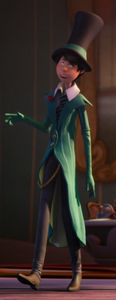
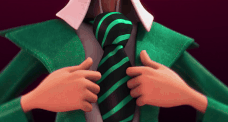
Hence the switch to permanent, longer, darker-green shoulder-length gloves identical to those he wore in the 1972 version when his company develops and he begins to engage in environmentally destructive activities on a regular, ongoing basis, symbolizing his greed taking over for a longer amount of time. During his time as a successful businessman, in addition to the long gloves, he appears way more polished and well-kept as his outfit switches to a suit consisting of a long, two-buttoned light-green tailcoat with lighter green stripes, black-and-grey vertical striped pants, a white shirt paired with a black and green striped tie and black dress shoes. He wears considerably more expensive accessories, such as a long black top hat with a green stripe, a gold chain hanging from his coat to his pants that makes a faint, almost inaudible jingling sound when he moves, and a small Truffula tree-shaped accessory in the collar of his coat. He occasionally wears blue, sparkly sunglasses in his song "How Bad Can I Be?" and (seemingly) when he's not in his office.

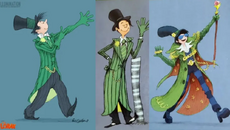
A considerable number of designs were explored before reaching the Once-ler's final conception, as the designer wanted to find a middle ground between nightmarish and whimsical so that it wouldn't obscure or overshadow the central message of Seuss's book, and intended the Once-ler's design to emphasize the key message that "we alone are responsible for the well-being of our world," resulting in several variations of concept art. Many of them were simply variations of non-human creatures, all sharing the long gloves similarity.[5] One of them appeared to portray the Once-ler significantly more narcissistic, showing off and wearing a gold chain around his neck emblazoned with "ONCELER," and a golden 'THNEED' ring on his right hand.
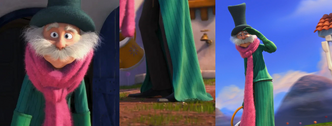
In the movie's present day, he is considerably older. He has wrinkles, his hair is white and hidden by his hat, and he has a huge mustache comically similar to the Lorax's. He wears an outfit resembling his green suit with a few differences: it lacks lapels, has darker stripes, and a lighter color. His gloves are baggier, potentially meaning he's lost weight, and he sports a makeshift waistband. The cape, unlike his previous one with a white interior, now mirrors the color of the rest of the outfit. He also wears a muted green top hat, a large pink Thneed scarf, and shorter dress shoes.
Trivia
- In the 2012 Film version, The Lorax addresses The Once-ler with the nicknames "beanpole" and "meathead," and in return The Once-ler calls him "mustache."
- Meanwhile, The Once-ler's mother addresses him with the "affectionate" nickname "Oncie" (/wˈʌnsiː/) as a false way to appear sympathetic towards him, sometimes using it condescendingly.
- In contrast to the 1972 version where his name was unknown but "Once-ler" was used as a placeholder for his actual name in his backstory, this could imply that in the 2012 version, his legal first name is actually "Once-ler" instead of being a nickname/label.
- Meanwhile, The Once-ler's mother addresses him with the "affectionate" nickname "Oncie" (/wˈʌnsiː/) as a false way to appear sympathetic towards him, sometimes using it condescendingly.
Filmography
Gallery
References
- ↑ "You speak for the trees? Well, I speak for men, and human opportunities." -The Lorax TV Special.
- ↑ The Lorax | Behind the Scenes - Ed Helms on The Onceler | Illumination: "And now, here I am playing the Once-ler in the new movie version of the classic story."
- ↑ "The Faceless" Character Trope on TV Tropes and Tropedia.
- ↑ "Rethinking Human Need: Seuss's The Lorax": "The Lorax, came out of my being angry. The ecology books I'd read were dull... In The Lorax I was out to attack what I think are evil things and let the chips fall where they might."
- ↑ The Lorax concept art from The Art of Eric Guillon, Parts One and Two
